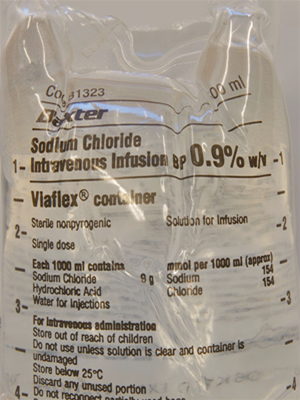Extracellular Compartment
0.9% NaCl distributes through the ECF.
Question: If you give 1 litre of 0.9% NaCl, how much remains in the intravascular compartment?

0.9% NaCl distributes through the ECF.
Question: If you give 1 litre of 0.9% NaCl, how much remains in the intravascular compartment?
Answer: The distribution ratio is the same as for the plasma; interstitial fluid ratio, which is 1:3. 250 ml remains in the intravascular space and 750 ml in the interstitial fluid compartment.
Question: What might happen if a large volume of this fluid is given?

0.9% NaCl distributes through the ECF.
Question: If you give 1 litre of 0.9% NaCl, how much remains in the intravascular compartment?
Answer: The distribution ratio is the same as for the plasma; interstitial fluid ratio, which is 1:3. 250 ml remains in the intravascular space and 750 ml in the interstitial fluid compartment.
Question: What might happen if a large volume of this fluid is given?
Answer: The extravascular part of the ECF will be expands with a large volume of fluid, which could lead to tissue oedema. This is seen if 0.9% saline alone is given rapidly for resuscitation.
Question: Why might 0.9% NaCl be preferred to Hartmann's solution during surgery or during resuscitation when there has been significant haemorrhage?

0.9% NaCl distributes through the ECF.
Question: If you give 1 litre of 0.9% NaCl, how much remains in the intravascular compartment?
Answer: The distribution ratio is the same as for the plasma; interstitial fluid ratio, which is 1:3. 250 ml remains in the intravascular space and 750 ml in the interstitial fluid compartment.
Question: What might happen if a large volume of this fluid is given?
Answer: The extravascular part of the ECF will be expands with a large volume of fluid, which could lead to tissue oedema. This is seen if 0.9% saline alone is given rapidly for resuscitation.
Question: Why might 0.9% NaCl be preferred to Hartmann's solution during surgery or during resuscitation when there has been significant haemorrhage?
Answer: The calcium in Hartmann's solution can cause clotting of administered blood, so should not be in the giving set either just before or just after blood has been given.
